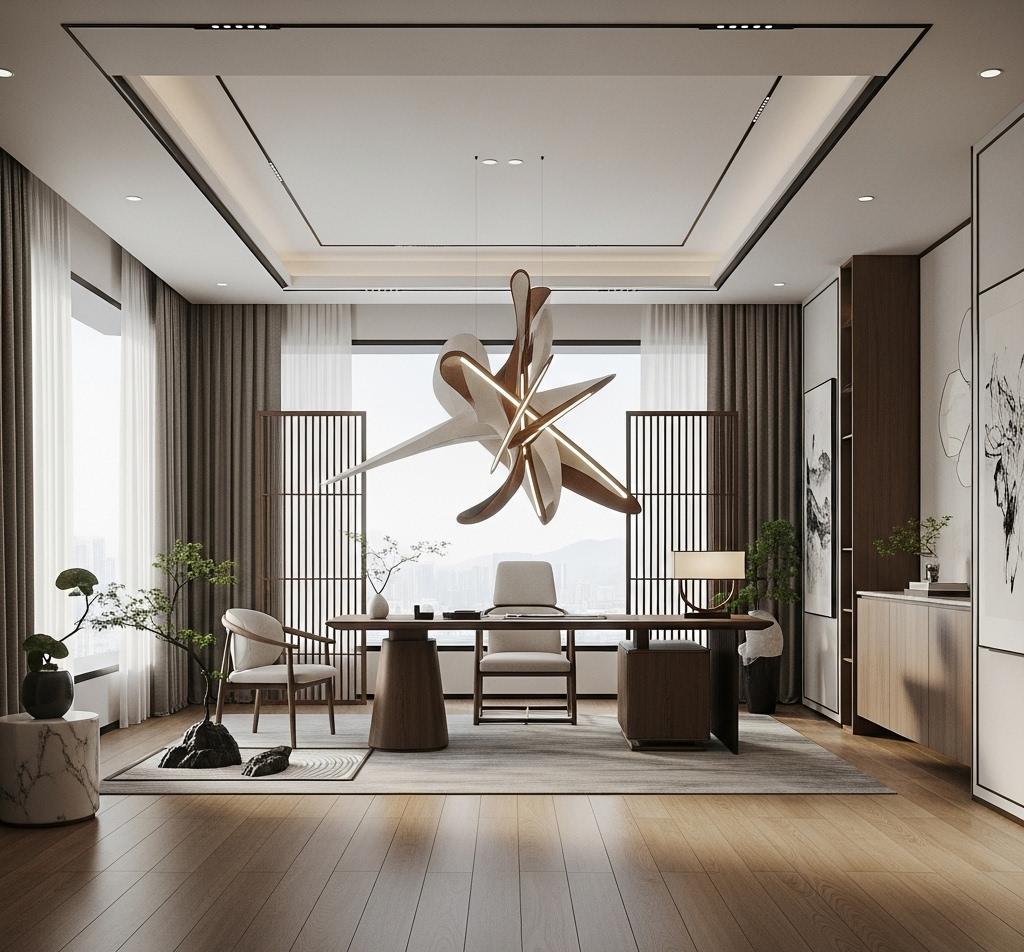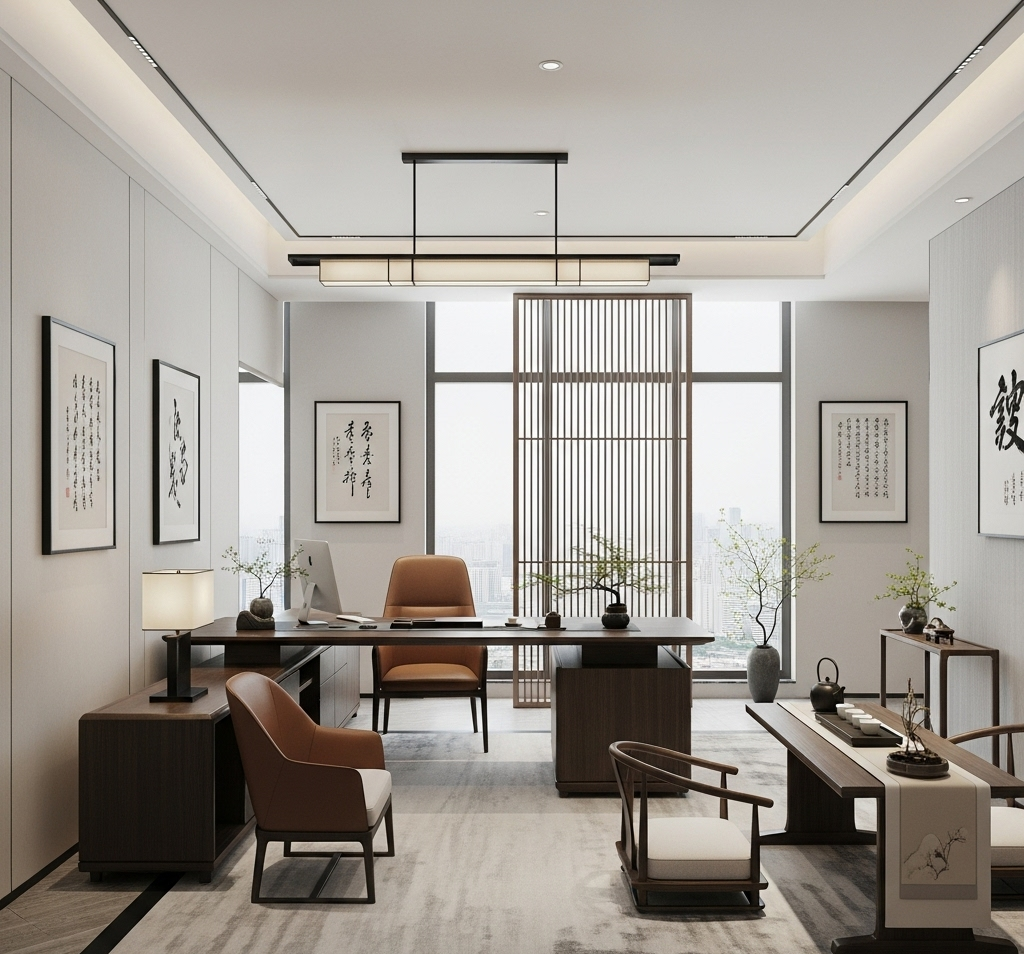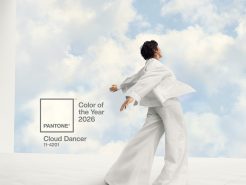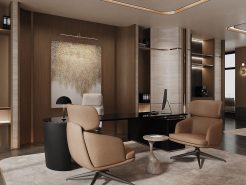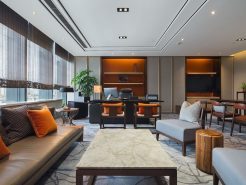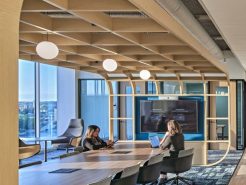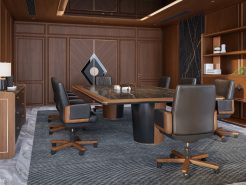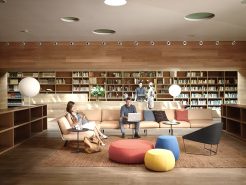Designing a chairman office is not simply arranging tables and chairs or choosing paint colors. It is a journey to create a space with a soul. Where every line of the interior reflects the stature, temperament and leadership thinking. In more than 10 years of designing spaces for leaders. I realized that: the most classy offices are not the most luxurious places. But the space has a harmony between traditional materials and modern thinking. In this article, I will share my practical experiences when designing a president’s office. With a subtle combination of traditional and modern materials.
1. Combining materials in designing the chairman office – The highlight of the difference
Why should we combine traditional and modern in designing the chairman office
In today’s design world, the fusion of tradition and modernity is not just a trend. It is also a subtle and profound aesthetic statement. Traditional materials carry historical depth, reminding us of our cultural roots and a sense of solidity and longevity. It is the familiarity of natural wood, the rustic breath of bamboo and rattan. Or the timeless elegance of classic marble. These elements are both materials and carry spiritual value. Evoking a warm and peaceful feeling for the workspace.
In contrast, modern materials represent innovative thinking. They are neat, sophisticated and full of creativity. Glass, metal or smart lighting systems open up a world of convenience, flexibility and high technology. Suitable for today’s contemporary lifestyle. When skillfully combining these two flows. The interior space will become both familiar and new. Where people feel the connection between the past and the future. Between traditional beauty and the spirit of constant innovation. This is the key to creating works that have both cultural depth and touch the hearts of today’s generation. (Predicting 5 trends in president’s office design in 2026).
Traditional materials are often used in designing the chairman office
In the treasure trove of traditional materials of Vietnam and the East in general. There are many materials that carry timeless beauty. Contributing to shaping the personality and depth of the interior space. Natural wood, especially wood lines such as walnut, red wood are always the first choice. Thanks to the luxury, warmth and solid feeling they bring. Wood also creates soft, natural grain lines. Something that no industrial material can perfectly reproduce.
In addition, natural stone is also favored for its grandeur and durability over time. Each stone slab is a unique work of art. Contributing to increasing the aesthetic value and depth of the space. Various traditional materials such as bamboo, rattan, brass or silk… Not only bear the mark of national cultural identity. But also create a very unique sophistication and softness. These materials, when used properly. Will bring a sense of closeness and nature. At the same time, honor the beauty of craftsmanship, which is increasingly appreciated in the modern world.
Modern materials should be brought into the workspace
With the increasingly developing urban lifestyle, the introduction of modern materials into interior design is inevitable to create a comfortable and flexible working space. And reflect the innovative spirit of the times. One of the popular material groups today is tempered glass and metal. Especially black steel and titanium-coated metal. They not only bring modern visual effects. But also help expand space, optimize light and bring a breath of technology to every detail.
In addition, materials such as composites, high-tech veneers or industrial leather are also widely used because of their flexibility. High durability and ability to simulate natural materials almost perfectly. These materials also help save costs. While still ensuring the aesthetic factor for the leader’s space.
It is impossible not to mention smart lighting systems and technical ceilings with hidden lights. These are “hidden but not hidden” elements. They help control the light flexibly according to needs and create subtle highlights. These modern options, when cleverly combined with traditional materials, will create a workspace that is both trendy and has depth. (Why should leather be used in the design of the president’s office?)
Principles to grasp when combining traditional and modern materials in designing the chairman office
To create a harmonious and impressive space. The combination of traditional and modern materials must follow clear design principles. First of all, the mixing ratio is a key factor in space design. The 60 – 40 rule should be applied to ensure balance. One style should not completely dominate the other. Instead, they should coexist, support and highlight each other.
A common approach is to use traditional materials as a foundation – providing stability and depth, then adding modern details to create creative accents. Conversely, for some specific projects, the modern space may be the main theme, while traditional elements will be the catalyst, bringing a cozy feeling, localizing the design.
In terms of color, neutral tones such as white, gray, wood brown, etc. should be prioritized to create a pleasant background for the eyes. Raw material details such as concrete, untreated wood or metallic shine from polished metal can be used as accents, creating visual depth and increasing the sense of luxury. A beautiful design is a skillful blend of materials, colors and light – all of which must tell a coherent and emotional aesthetic story.
2. Sharing practical experiences from completed projects – When modern materials meet Asian spirit
The project of designing the president’s office for Mr. H – a CEO in the technology industry born in 1970. Is one of the most interesting problems we have ever done. Mr. H is a perfectionist, sophisticated. And especially requires that his working space must demonstrate his leadership class, modern thinking. But still must have an Asian breath – calm, profound and culturally profound.
Practical solutions in designing the chairman office
Our solution starts with defining the material language. This is the core element to shape the spirit of the space. Walnut wood, with its warm brown color and soft wave-like grain. We chose it as the main material for the entire cabinet system, desk and ceiling panels. This wood material not only exudes power and class. But also maintains the closeness, warmth, reminiscent of the rustic, profound spirit of traditional Asian space. The wall behind the chairman’s chair is covered with ancient stone, creating a visual highlight and increasing the depth of feng shui. Frosted glass walls are arranged along the space. Helps to gently welcome natural light. At the same time, creating openness for the chairman’s room. While still maintaining the necessary privacy.
The interior lines are designed with clear, minimalist but powerful blocks. Showing determination and strategic vision. The overall space is both modern and quiet. Like Mr. H’s leadership style: profound, courageous and full of philosophy. (President’s office interior design – Laroma or Vienasez?).
Conclude
Designing the chairman office is not just a matter of aesthetics or functionality. It is the art of creating a space with character. Where every detail speaks of the leader’s stature. When traditional materials meet modern breath. The space is no longer simply an office, but becomes a personal statement. As an architect, I believe that a successful design is when customers and partners step in. They will immediately feel the owner’s temperament, even without exchanging a word. Therefore, do not stop at creating a room. But create a unique and unmistakable mark. That is how leaders leave a legacy and start from where they sit every day.
=====\
PROCE – TOTAL LUXURY OFFICE SOLUTION
Website: https://proce.vn/
Youtube: https://www.youtube.com/@noithatvanphonghangsang
Fanpage: https://www.facebook.com/vanphongnhapkhauProce
GG Business: https://business.google.com/dashboard/l/15115233216900975876
Linkedin: https://www.linkedin.com/company/74359718/admin/
Hotline: 090.115.6767
#thiet_ke_phong_chu_tịch; thiet_ke_phong_chu_tich_chuan_sang;
#thiet_ke_noi_that_phong_chu_tich; #thiet_ke_phong_chu_tich_dang_cap
#noi_that_trong_thiet_ke_phong_chu_tich; Proce_thiet_ke_phong_chu_tich
#thiet_ke_phong_chu_tich_chat


